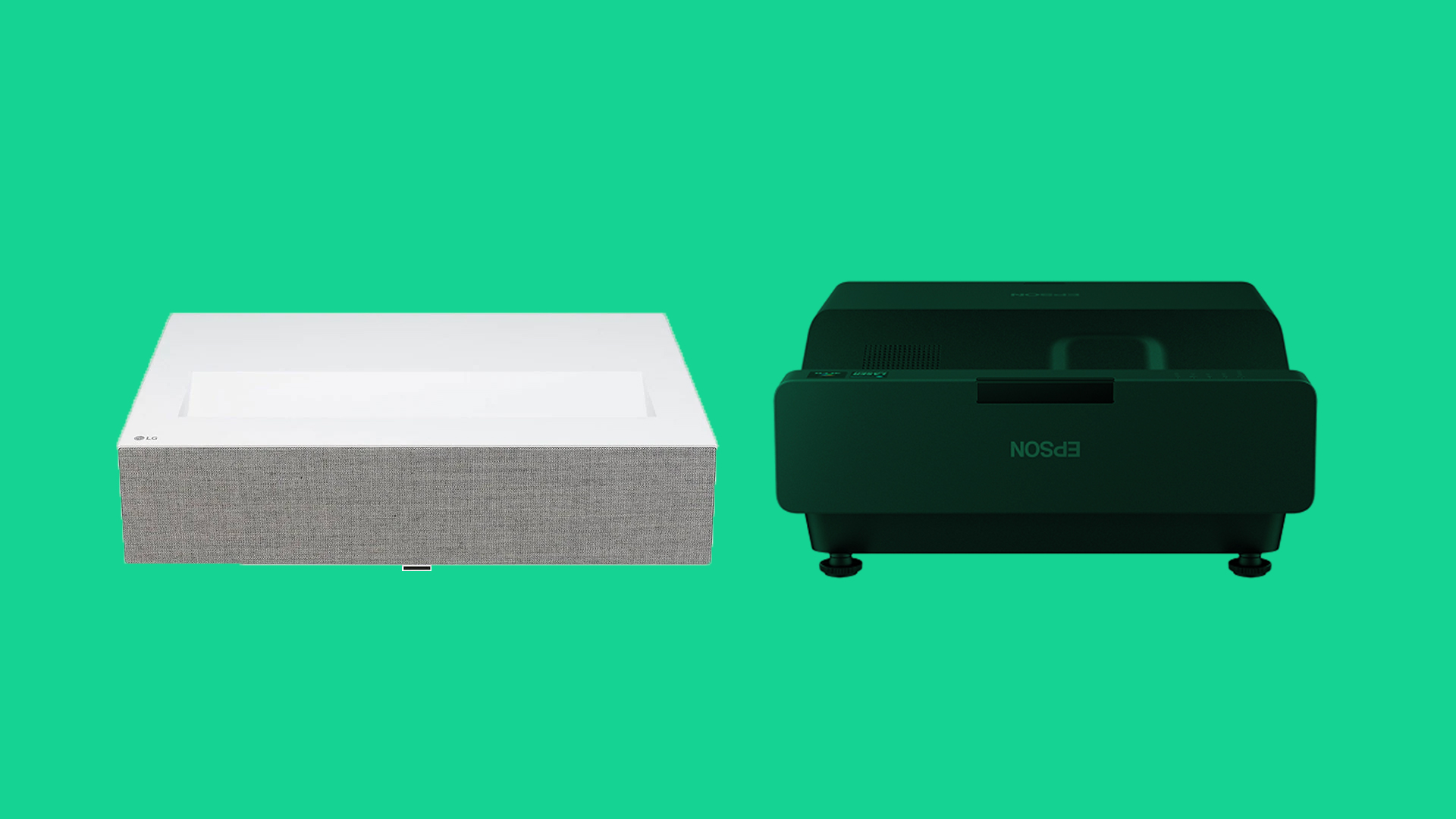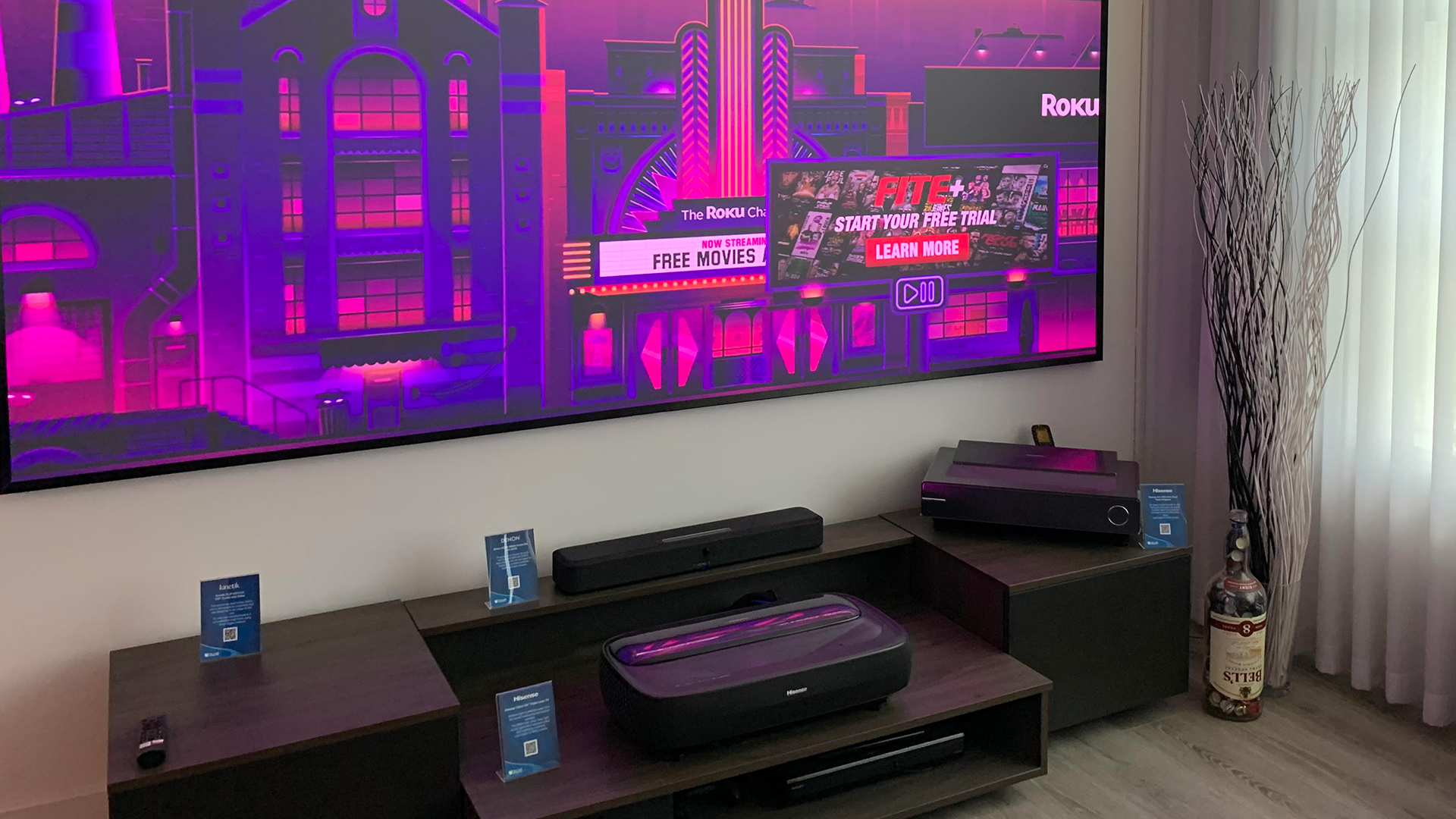Ultra short throw projectors explained – why you might want one over a TV
A very big screen from a small box

Ultra short throw (or UST) projectors standout for their inconspicuous positioning and brighter images. Unlike regular home theater projectors that need to be a certain distance from the screen, ultra short throw projectors can sit just centimetres from a wall meaning they are suited to most living rooms.
The fact that they don’t get in the way and tend to have brighter images are major advantages over the best 4K projectors out there, and with an increasing number of models to choose from, there are now even more reasons why you might want one over one of the best 4K TVs.
Some of the best offer built-in audio that supports Dolby Atmos, have 4K resolution with HDR, and can project image sizes not yet available in big-screen TVs. But what exactly are ultra short throw projectors, how do they work and why would you buy one?
What are ultra short throw projectors?
Ultra short throw projectors have come a long way from being exclusively found in classrooms and boardrooms. Thanks to advancements in laser technology, glass making techniques for wide-angle lenses and freeform concave mirrors, these types of projectors are now becoming more readily and widely available for home theaters.
The major benefits of choosing an ultra short throw projector over a regular projector are a brighter image due to the laser light technology typically used, an ability to view in daylight environments, and a more compact installation that lets you move around the room without casting shadows on the screen.
Ultra short throw projectors also offer a lot of flexibility by not having to be installed into the ceiling or far away from the screen, although they can have very specific placement instructions. This varies among models but essentially they require a certain height and distance from the wall, which can take a bit of adjusting to get right during installation – most do have keystone alignment but this does impact image quality by lessening resolution.
Another key difference between regular projectors and ultra short throw is the screen type required. While this is generally important with projectors anyway to get the most out of the picture quality, with ultra-short throw projectors there’s the angle that the image is projected at that you have to consider.
Sign up for breaking news, reviews, opinion, top tech deals, and more.
The best screen for an ultra short throw projector is called a ceiling light rejecting (CLR) screen. The rigid texture of the design means that ambient light from above is absorbed, while light from the projector below is reflected back to the viewer. This lets the projector be used in a room with overhead lights, where the impact of those lights on picture quality is minimized.

How do ultra short throw projectors work?
Instead of throwing light directly onto a screen, ultra short throw projectors first direct the light onto a mirror, which is how they are able to be positioned so close to a wall.
When it comes to projectors, the main difference that separates a short throw vs long throw vs ultra short throw is the distance between the projector itself and the screen. This is what ultimately determines the type of throwing capability that will be required.
And the ability to project a certain display size on a screen at different distances is determined by the lens. Ultra short throw projectors have some of the most expensive lenses due to the aspherical shape and mirrors required.
Most projectors, for instance, require roughly one inch of distance from the wall for every inch of the display size. This is where ultra short throw projectors really shine, as they can project more than 100 inches while being just a foot away from a wall.
What makes these projectors brighter than the rest is laser technology. It is increasingly being adopted due to the benefits it offers, including a longer lifespan – they usually last for around 20,000 hours compared to a typical lamp projector’s 2,500 hours – greater color capacity and faster powering modes.
Although most ultra short throw projectors have one laser with a color wheel, there are some premium projectors that have three lasers built in for red, green and blue, which are overlaid on top of one another to achieve more vivid colors.
Is ultra short throw worth the money?
The price of ultra short throw projectors has come down in recent years thanks to advancements in the technology behind the light engine that powers them. However, they’re still generally more expensive than regular projectors.
Ultra short throw projectors do offer extra value over standard projectors though. For instance, most have built-in audio unlike long throw projectors, which are often situated above and behind a couch from a distance.
There are even some ultra short throw projectors that have sound quality on par with one of the best soundbars. But of course any projector setup will always be further elevated by adding the best home theater system or even just a pair of the best wireless headphones, especially to drown out that fan noise.
Many of the newer ultra short projector models also have added features such as access to streaming services and built-in digital TV tuner, just like one of the best TVs.
Should you buy an ultra short throw projector?
If you’re wondering ‘should I buy an ultra short throw projector?’, then it comes down to if you want the cinematic effect of a projector for watching movies and playing video games but also the added flexibility of being able to watch TV during the day, as the boosted brightness makes these projectors a top choice compared to other projectors.
Sure, there are some premium TVs that don’t cost as much as an ultra short throw projector but It’s likely that if you have the space for one of the best 65-inch TVs or best 75-inch TVs then you might also want to make the most of it with this 100-inch plus capability given the added immersiveness.

Amelia became the Senior Editor for Home Entertainment at TechRadar in the UK in April 2023. With a background of more than eight years in tech and finance publishing, she's now leading our coverage to bring you a fresh perspective on everything to do with TV and audio. When she's not tinkering with the latest gadgets and gizmos in the ever-evolving world of home entertainment, you’ll find her watching movies, taking pictures and travelling.